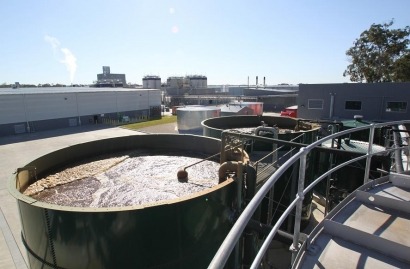
While CST Wastewater Solutions main area of business, as its name suggests, is installing water recovery plants, the company has found that recovering waste water and making use of the organic matter contained therein to produce biogas go hand in hand.
The new waste water treatment and green energy plant at the $120 million Pacific Beverages’ Bluetongue Brewery is a good example of just that, providing valuable renewable energy for the brewery, reducing its dependence on fossil fuels and ultimately cutting overall energy needs.
The plant – engineered by Australia’s CST Wastewater Solutions in partnership with Global Water Engineering – has achieved all the high environmental performance targets set by Pacific Beverages, a SABMiller/Coca Cola Amatil joint venture, says CST Wastewater Solutions Managing Director, Mike Bambridge.
The plant was also a finalist in two categories of this year’s Engineering Excellence Awards, Sydney 2011, conducted by Engineers Australia, which attracted a record field of more than 90 entrants. Bluetongue was a finalist in the Environmental and Heritage category and the products, manufacturing, facilities and processes category.
As well as reducing water usage to 2.2l/ l litres of beer produced (a figure that is amongst the best in the world and certainly well above the global average of 4-5 litres of water to every one litre of beer), the anaerobic biogas plant produces sufficient green energy (methane) from its closed anaerobic reactor to power a designated steam boiler and cut the brewery’s overall energy consumption by about 15 percent. This equates to about 300,000 Mj.
Bambridge says this the plant indirectly reduces the brewery’s carbon footprint by reducing the brewery’s demands on fossil fuels and the electricity needs for wastewater treatment by using energy-friendly anaerobic pre-treatment technology in which GWE is a world leader.
“And the plant produces treated effluent to be safely reused as process and cleaning water within the brewery, reducing by around 50 percent the need for fresh water, thereby greatly contributing to reducing the amount of water typically used to produce a litre of beer.”
“This is a landmark achievement of water conservation and green energy production, achieved by combining the latest versions of advanced and reliable technologies available globally,” said Bambridge. “It demonstrates the technology’s practicality for extensive use not only throughout the Australian food and beverage sector – which involves more than 20,000 companies – but also globally.”
Users of GWE technologies extend from the Bluetongue Brewery to global players such as Budweiser, Chang, Carlsberg, Coca Cola, Corn Products Int’l., Danone, Fosters, Heineken, Interbrew, Kraft, National Starch & Chemicals, Nestlé, Pepsi Cola, SAB-Miller, San Miguel, Singha, Sunkist and Tsingtao.
For additional information:

